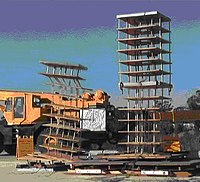
Photo from wikipedia
Abstract The reactivation of the Chelungpu Fault triggered the 1999 Chi-Chi Mw 7.6 earthquake, resulting in substantial ground surface ruptures and severe damage. After the earthquake, the surveys organized by… Click to show full abstract
Abstract The reactivation of the Chelungpu Fault triggered the 1999 Chi-Chi Mw 7.6 earthquake, resulting in substantial ground surface ruptures and severe damage. After the earthquake, the surveys organized by the Central Geology Survey (CGS) of Taiwan and the National Center for Research on Earthquake Engineering (NCREE) immediately investigated a variety of cases related to engineering structures damaged by substantial ground deformation. The investigations gathered valuable in-situ data before human activities disturbed the local setting and altered co-seismic features of interest, providing opportunities for studying the interaction between surface rupture and engineering structures. This study outlines the reconnaissance of damaged engineering structures in Shigang District that cover three typical types of foundations and analyzes the fault geometry and fault slip at the local scale to construct a geomechanical model for numerical simulation. In addition, 3-dimensional (3D) modeling was performed for each case study to investigate the damage mechanisms of the structures subjected to the substantial ground deformations by using PFC3D (Particle Flow Code 3D), which is based on the discrete element method (DEM). The results of the DEM analyses, which have been calibrated with the in-situ data, showed the ability to evaluate the overall ground deformation, the detection of structural movement, and the critical elements of progressive collapse during faulting. This study demonstrates that the 3D DEM simulation is a reliable analysis tool for studying earthquake fault rupture-overburden layer-engineering structure interactions and can produce useful information for hazard assessment with an acceptable computation time. The 3D DEM analysis is therefore suggested to be applied to assess the potential damage scenarios for the engineering structures located in active fault zones.
Journal Title: Engineering Geology
Year Published: 2021
Link to full text (if available)
Share on Social Media: Sign Up to like & get
recommendations!